Wenzheng Chen
NVIDIA
Vision-Language Models as Differentiable Semantic and Spatial Rewards for Text-to-3D Generation
Sep 19, 2025Abstract:Score Distillation Sampling (SDS) enables high-quality text-to-3D generation by supervising 3D models through the denoising of multi-view 2D renderings, using a pretrained text-to-image diffusion model to align with the input prompt and ensure 3D consistency. However, existing SDS-based methods face two fundamental limitations: (1) their reliance on CLIP-style text encoders leads to coarse semantic alignment and struggles with fine-grained prompts; and (2) 2D diffusion priors lack explicit 3D spatial constraints, resulting in geometric inconsistencies and inaccurate object relationships in multi-object scenes. To address these challenges, we propose VLM3D, a novel text-to-3D generation framework that integrates large vision-language models (VLMs) into the SDS pipeline as differentiable semantic and spatial priors. Unlike standard text-to-image diffusion priors, VLMs leverage rich language-grounded supervision that enables fine-grained prompt alignment. Moreover, their inherent vision language modeling provides strong spatial understanding, which significantly enhances 3D consistency for single-object generation and improves relational reasoning in multi-object scenes. We instantiate VLM3D based on the open-source Qwen2.5-VL model and evaluate it on the GPTeval3D benchmark. Experiments across diverse objects and complex scenes show that VLM3D significantly outperforms prior SDS-based methods in semantic fidelity, geometric coherence, and spatial correctness.
Dive3D: Diverse Distillation-based Text-to-3D Generation via Score Implicit Matching
Jun 16, 2025Abstract:Distilling pre-trained 2D diffusion models into 3D assets has driven remarkable advances in text-to-3D synthesis. However, existing methods typically rely on Score Distillation Sampling (SDS) loss, which involves asymmetric KL divergence--a formulation that inherently favors mode-seeking behavior and limits generation diversity. In this paper, we introduce Dive3D, a novel text-to-3D generation framework that replaces KL-based objectives with Score Implicit Matching (SIM) loss, a score-based objective that effectively mitigates mode collapse. Furthermore, Dive3D integrates both diffusion distillation and reward-guided optimization under a unified divergence perspective. Such reformulation, together with SIM loss, yields significantly more diverse 3D outputs while improving text alignment, human preference, and overall visual fidelity. We validate Dive3D across various 2D-to-3D prompts and find that it consistently outperforms prior methods in qualitative assessments, including diversity, photorealism, and aesthetic appeal. We further evaluate its performance on the GPTEval3D benchmark, comparing against nine state-of-the-art baselines. Dive3D also achieves strong results on quantitative metrics, including text-asset alignment, 3D plausibility, text-geometry consistency, texture quality, and geometric detail.
The Less You Depend, The More You Learn: Synthesizing Novel Views from Sparse, Unposed Images without Any 3D Knowledge
Jun 11, 2025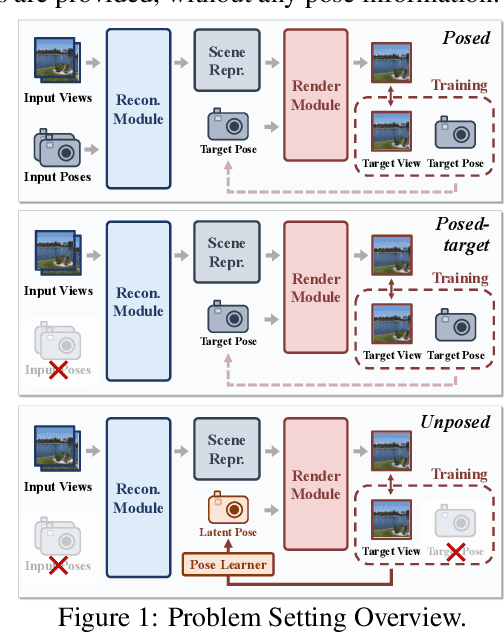
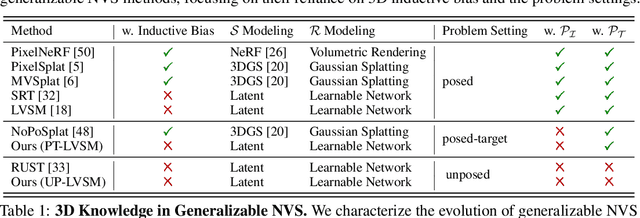
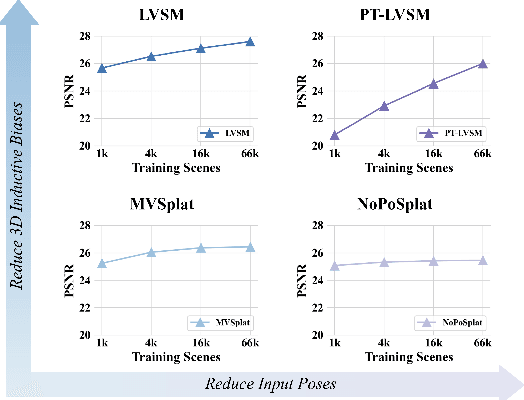
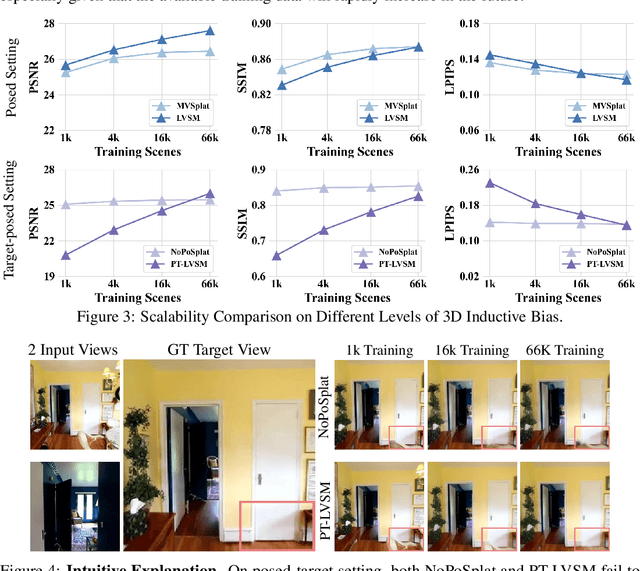
Abstract:We consider the problem of generalizable novel view synthesis (NVS), which aims to generate photorealistic novel views from sparse or even unposed 2D images without per-scene optimization. This task remains fundamentally challenging, as it requires inferring 3D structure from incomplete and ambiguous 2D observations. Early approaches typically rely on strong 3D knowledge, including architectural 3D inductive biases (e.g., embedding explicit 3D representations, such as NeRF or 3DGS, into network design) and ground-truth camera poses for both input and target views. While recent efforts have sought to reduce the 3D inductive bias or the dependence on known camera poses of input views, critical questions regarding the role of 3D knowledge and the necessity of circumventing its use remain under-explored. In this work, we conduct a systematic analysis on the 3D knowledge and uncover a critical trend: the performance of methods that requires less 3D knowledge accelerates more as data scales, eventually achieving performance on par with their 3D knowledge-driven counterparts, which highlights the increasing importance of reducing dependence on 3D knowledge in the era of large-scale data. Motivated by and following this trend, we propose a novel NVS framework that minimizes 3D inductive bias and pose dependence for both input and target views. By eliminating this 3D knowledge, our method fully leverages data scaling and learns implicit 3D awareness directly from sparse 2D images, without any 3D inductive bias or pose annotation during training. Extensive experiments demonstrate that our model generates photorealistic and 3D-consistent novel views, achieving even comparable performance with methods that rely on posed inputs, thereby validating the feasibility and effectiveness of our data-centric paradigm. Project page: https://pku-vcl-geometry.github.io/Less3Depend/ .
RainyGS: Efficient Rain Synthesis with Physically-Based Gaussian Splatting
Mar 27, 2025Abstract:We consider the problem of adding dynamic rain effects to in-the-wild scenes in a physically-correct manner. Recent advances in scene modeling have made significant progress, with NeRF and 3DGS techniques emerging as powerful tools for reconstructing complex scenes. However, while effective for novel view synthesis, these methods typically struggle with challenging scene editing tasks, such as physics-based rain simulation. In contrast, traditional physics-based simulations can generate realistic rain effects, such as raindrops and splashes, but they often rely on skilled artists to carefully set up high-fidelity scenes. This process lacks flexibility and scalability, limiting its applicability to broader, open-world environments. In this work, we introduce RainyGS, a novel approach that leverages the strengths of both physics-based modeling and 3DGS to generate photorealistic, dynamic rain effects in open-world scenes with physical accuracy. At the core of our method is the integration of physically-based raindrop and shallow water simulation techniques within the fast 3DGS rendering framework, enabling realistic and efficient simulations of raindrop behavior, splashes, and reflections. Our method supports synthesizing rain effects at over 30 fps, offering users flexible control over rain intensity -- from light drizzles to heavy downpours. We demonstrate that RainyGS performs effectively for both real-world outdoor scenes and large-scale driving scenarios, delivering more photorealistic and physically-accurate rain effects compared to state-of-the-art methods. Project page can be found at https://pku-vcl-geometry.github.io/RainyGS/
GeoSplatting: Towards Geometry Guided Gaussian Splatting for Physically-based Inverse Rendering
Oct 31, 2024Abstract:We consider the problem of physically-based inverse rendering using 3D Gaussian Splatting (3DGS) representations. While recent 3DGS methods have achieved remarkable results in novel view synthesis (NVS), accurately capturing high-fidelity geometry, physically interpretable materials and lighting remains challenging, as it requires precise geometry modeling to provide accurate surface normals, along with physically-based rendering (PBR) techniques to ensure correct material and lighting disentanglement. Previous 3DGS methods resort to approximating surface normals, but often struggle with noisy local geometry, leading to inaccurate normal estimation and suboptimal material-lighting decomposition. In this paper, we introduce GeoSplatting, a novel hybrid representation that augments 3DGS with explicit geometric guidance and differentiable PBR equations. Specifically, we bridge isosurface and 3DGS together, where we first extract isosurface mesh from a scalar field, then convert it into 3DGS points and formulate PBR equations for them in a fully differentiable manner. In GeoSplatting, 3DGS is grounded on the mesh geometry, enabling precise surface normal modeling, which facilitates the use of PBR frameworks for material decomposition. This approach further maintains the efficiency and quality of NVS from 3DGS while ensuring accurate geometry from the isosurface. Comprehensive evaluations across diverse datasets demonstrate the superiority of GeoSplatting, consistently outperforming existing methods both quantitatively and qualitatively.
Learning Diffusion Model from Noisy Measurement using Principled Expectation-Maximization Method
Oct 15, 2024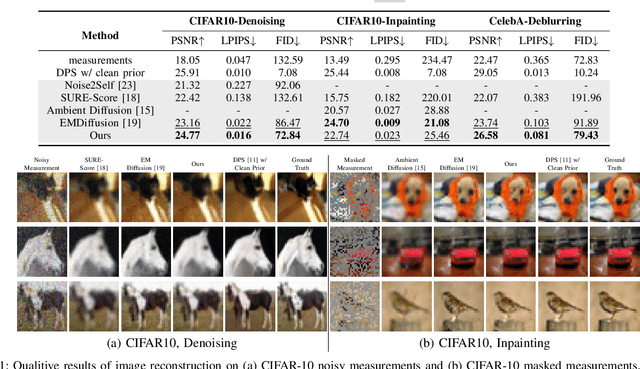
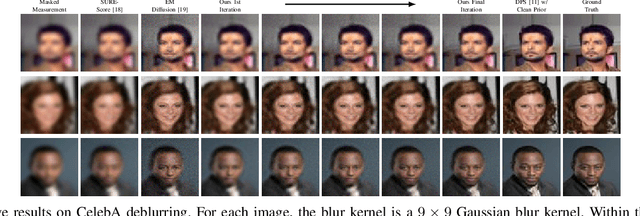
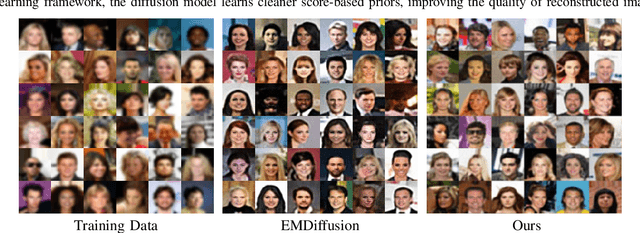
Abstract:Diffusion models have demonstrated exceptional ability in modeling complex image distributions, making them versatile plug-and-play priors for solving imaging inverse problems. However, their reliance on large-scale clean datasets for training limits their applicability in scenarios where acquiring clean data is costly or impractical. Recent approaches have attempted to learn diffusion models directly from corrupted measurements, but these methods either lack theoretical convergence guarantees or are restricted to specific types of data corruption. In this paper, we propose a principled expectation-maximization (EM) framework that iteratively learns diffusion models from noisy data with arbitrary corruption types. Our framework employs a plug-and-play Monte Carlo method to accurately estimate clean images from noisy measurements, followed by training the diffusion model using the reconstructed images. This process alternates between estimation and training until convergence. We evaluate the performance of our method across various imaging tasks, including inpainting, denoising, and deblurring. Experimental results demonstrate that our approach enables the learning of high-fidelity diffusion priors from noisy data, significantly enhancing reconstruction quality in imaging inverse problems.
Integrating Amortized Inference with Diffusion Models for Learning Clean Distribution from Corrupted Images
Jul 15, 2024



Abstract:Diffusion models (DMs) have emerged as powerful generative models for solving inverse problems, offering a good approximation of prior distributions of real-world image data. Typically, diffusion models rely on large-scale clean signals to accurately learn the score functions of ground truth clean image distributions. However, such a requirement for large amounts of clean data is often impractical in real-world applications, especially in fields where data samples are expensive to obtain. To address this limitation, in this work, we introduce \emph{FlowDiff}, a novel joint training paradigm that leverages a conditional normalizing flow model to facilitate the training of diffusion models on corrupted data sources. The conditional normalizing flow try to learn to recover clean images through a novel amortized inference mechanism, and can thus effectively facilitate the diffusion model's training with corrupted data. On the other side, diffusion models provide strong priors which in turn improve the quality of image recovery. The flow model and the diffusion model can therefore promote each other and demonstrate strong empirical performances. Our elaborate experiment shows that FlowDiff can effectively learn clean distributions across a wide range of corrupted data sources, such as noisy and blurry images. It consistently outperforms existing baselines with significant margins under identical conditions. Additionally, we also study the learned diffusion prior, observing its superior performance in downstream computational imaging tasks, including inpainting, denoising, and deblurring.
Blind Inversion using Latent Diffusion Priors
Jul 01, 2024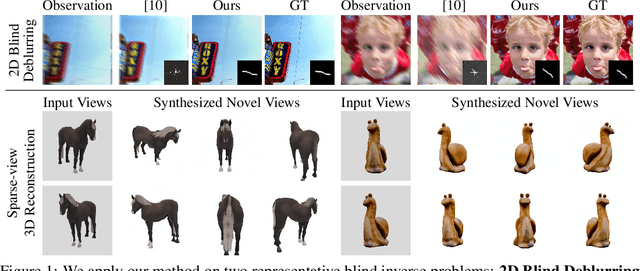

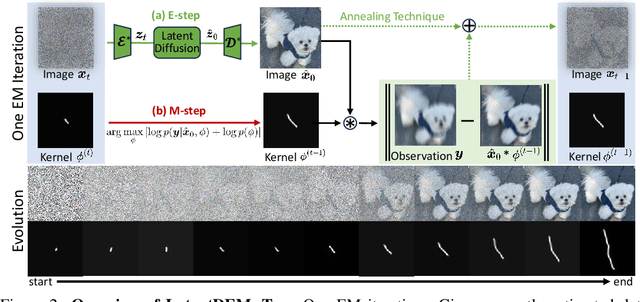

Abstract:Diffusion models have emerged as powerful tools for solving inverse problems due to their exceptional ability to model complex prior distributions. However, existing methods predominantly assume known forward operators (i.e., non-blind), limiting their applicability in practical settings where acquiring such operators is costly. Additionally, many current approaches rely on pixel-space diffusion models, leaving the potential of more powerful latent diffusion models (LDMs) underexplored. In this paper, we introduce LatentDEM, an innovative technique that addresses more challenging blind inverse problems using latent diffusion priors. At the core of our method is solving blind inverse problems within an iterative Expectation-Maximization (EM) framework: (1) the E-step recovers clean images from corrupted observations using LDM priors and a known forward model, and (2) the M-step estimates the forward operator based on the recovered images. Additionally, we propose two novel optimization techniques tailored for LDM priors and EM frameworks, yielding more accurate and efficient blind inversion results. As a general framework, LatentDEM supports both linear and non-linear inverse problems. Beyond common 2D image restoration tasks, it enables new capabilities in non-linear 3D inverse rendering problems. We validate LatentDEM's performance on representative 2D blind deblurring and 3D sparse-view reconstruction tasks, demonstrating its superior efficacy over prior arts.
An Expectation-Maximization Algorithm for Training Clean Diffusion Models from Corrupted Observations
Jul 01, 2024
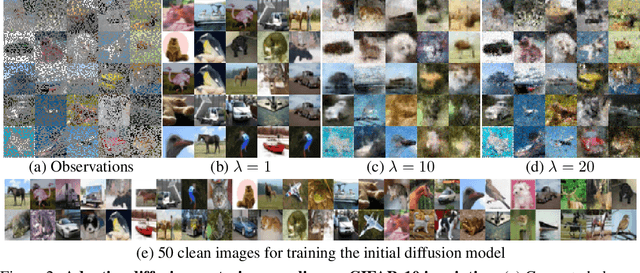

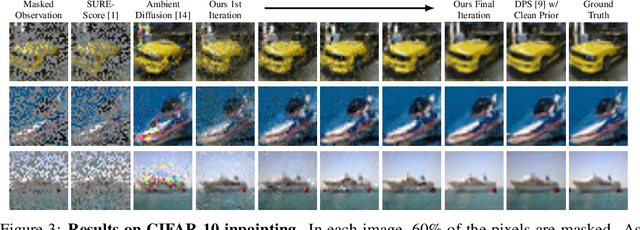
Abstract:Diffusion models excel in solving imaging inverse problems due to their ability to model complex image priors. However, their reliance on large, clean datasets for training limits their practical use where clean data is scarce. In this paper, we propose EMDiffusion, an expectation-maximization (EM) approach to train diffusion models from corrupted observations. Our method alternates between reconstructing clean images from corrupted data using a known diffusion model (E-step) and refining diffusion model weights based on these reconstructions (M-step). This iterative process leads the learned diffusion model to gradually converge to the true clean data distribution. We validate our method through extensive experiments on diverse computational imaging tasks, including random inpainting, denoising, and deblurring, achieving new state-of-the-art performance.
4D Gaussian Splatting: Towards Efficient Novel View Synthesis for Dynamic Scenes
Feb 07, 2024Abstract:We consider the problem of novel view synthesis (NVS) for dynamic scenes. Recent neural approaches have accomplished exceptional NVS results for static 3D scenes, but extensions to 4D time-varying scenes remain non-trivial. Prior efforts often encode dynamics by learning a canonical space plus implicit or explicit deformation fields, which struggle in challenging scenarios like sudden movements or capturing high-fidelity renderings. In this paper, we introduce 4D Gaussian Splatting (4DGS), a novel method that represents dynamic scenes with anisotropic 4D XYZT Gaussians, inspired by the success of 3D Gaussian Splatting in static scenes. We model dynamics at each timestamp by temporally slicing the 4D Gaussians, which naturally compose dynamic 3D Gaussians and can be seamlessly projected into images. As an explicit spatial-temporal representation, 4DGS demonstrates powerful capabilities for modeling complicated dynamics and fine details, especially for scenes with abrupt motions. We further implement our temporal slicing and splatting techniques in a highly optimized CUDA acceleration framework, achieving real-time inference rendering speeds of up to 277 FPS on an RTX 3090 GPU and 583 FPS on an RTX 4090 GPU. Rigorous evaluations on scenes with diverse motions showcase the superior efficiency and effectiveness of 4DGS, which consistently outperforms existing methods both quantitatively and qualitatively.
 Add to Chrome
Add to Chrome Add to Firefox
Add to Firefox Add to Edge
Add to Edge